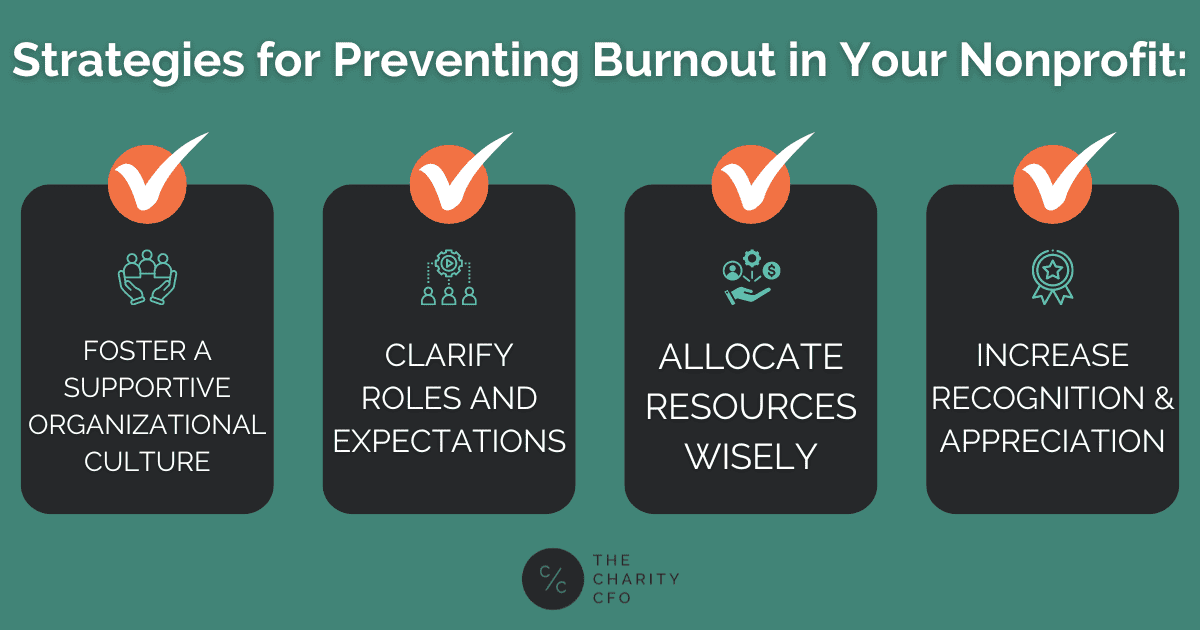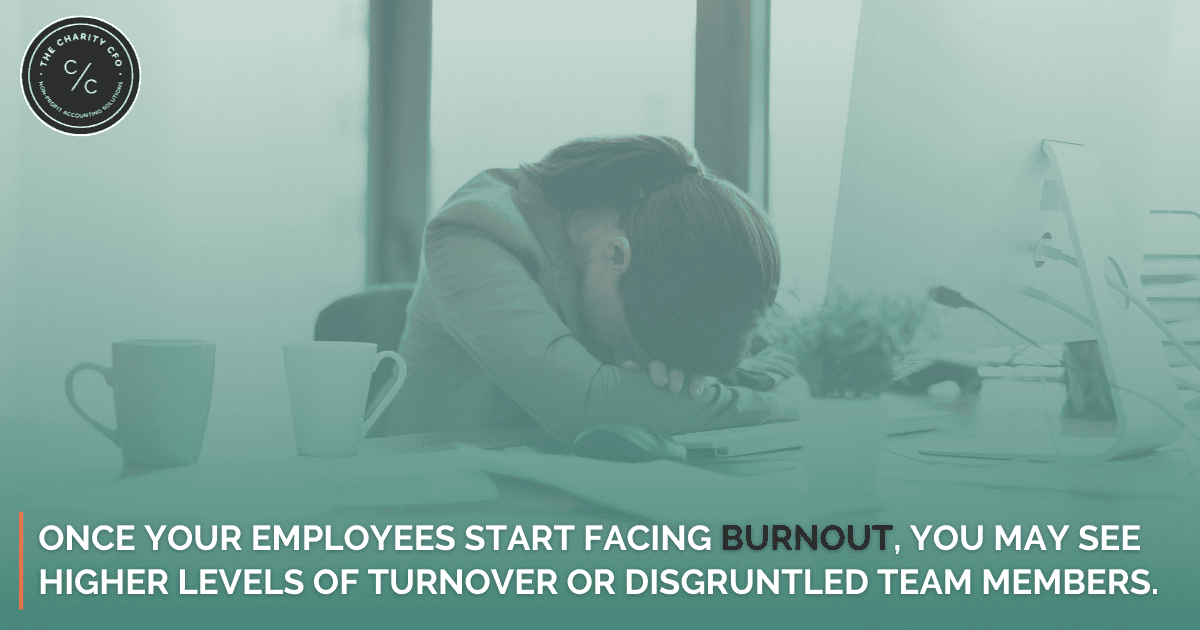How to Prevent Burnout in Your Nonprofit
The term burnout is more than a buzzword. In many nonprofits, burnout is the emotional, physical, and mental exhaustion of employees due to prolonged stress. The impact of this goes beyond individual well-being and can affect your organization’s effectiveness and ability to advance your mission.
Keep reading to learn how burnout can happen and get tips for implementing a burnout prevention strategy for your organization.

Understanding Burnout in Nonprofit Organizations
Burnout at work can happen to anyone. Jobs that require long hours or have high-stress environments can lead to this.
Unfortunately, many nonprofit roles have unique stressors that can cause burnout, such as:
- Passion for the mission that adds personal investment to work
- Limited financial resources
- Lack of staff and heavy workloads
- Emotional tolls related to working on sensitive issues such as poverty, abuse, or social injustice
- Ambiguity in each staff member’s role
- Unrealistic expectations from the public, donors, or the board of directors
A nonprofit with high levels of employee burnout can’t operate at optimal efficiency. Burnout can cause decreased productivity and high turnover rates in staff. Additionally, burnout can cause the quality of your services or programs to diminish as employees pay less attention to detail or offer lower-quality customer service. This can also have cultural impacts within your organization such as low morale and high cynicism among employees.
But burnout doesn’t only affect employee relationships. High levels of burnout could pose legal, compliance, and financial risks as employees lose focus or drive in their jobs.
Signs and Symptoms
The signs and symptoms of burnout can manifest both physically and mentally. Many employees facing burnout experience a combination of symptoms, including:
- Chronic fatigue
- Insomnia
- Forgetfulness or impaired concentration
- Chest pain and heart palpitations
- Gastrointestinal pain or issues
- Increased chance of illness
- Loss of appetite or significant weight loss
- Anxiety
- Depression
Strategies for Preventing Burnout in Your Nonprofit
Although nonprofit organizations unfortunately regularly see high levels of burnout, there are steps you can take to prevent burnout in your nonprofit. Consider these four strategies to improve your workplace culture and reduce burnout in your nonprofit employees.
Foster a Supportive Organizational Culture
The best way to help prevent burnout is to create a supportive culture in your organization. You can do this by promoting open communication and transparency throughout your nonprofit. Your staff should feel confident that they can rely on other team members to help one another succeed.
In addition to communication, you can help reduce burnout by prioritizing employee wellness and mental health. Offering wellness programs, family-friendly policies, or other mental health benefits for employees gives them the resources they need to proactively manage stress and stop burnout.
Another way to create a supportive organizational culture is to provide employees with opportunities for professional development and growth. On-the-job training, mentorship programs, and career planning sessions can help employees get more out of their jobs.
Clarify Roles and Expectations
Many nonprofit employees face burnout due to unclear expectations or duties of their roles. With many nonprofits facing limited staff and financial resources, it’s common for employees to pick up additional duties and wear many hats in their roles. While this can help foster a sense of pride and teamwork, it can also quickly cause burnout as staff are unsure of what’s required of them.
You can combat this problem by clearly defining employee roles and expectations. Well-defined job descriptions help employees understand what’s expected of them from the start. You’ll also need to set realistic goals and priorities in your organization to prevent the need to overextend employees.
Allocate Resources Wisely
It’s no secret that many nonprofits face limited resources, especially financial resources. As a leader in your organization, you must advocate for adequate funding and resources for your employees. You may need to increase fundraising efforts, grant applications, or program fees to help bridge the gap between limited and adequate funding.
You can also improve your resource management based on historical spending and revenue. Comparing your nonprofit budget to actual, for example, can help you better understand where resources are going. You can use that data to make more informed decisions about spending and look for areas where you can reduce expenses.
Outsourcing can be a great way to reduce costs and improve your team’s efficiency. Consider financial management as an example. You might rely on your administrative team to handle all of your accounting and bookkeeping work as well.
This leaves them with less time to process other aspects of your organization. You could remedy this by outsourcing bookkeeping to remove a significant stress factor from your team.
Increase Recognition and Appreciation
A simple way to help reduce burnout in your organization is to create a recognition program for employees. Sometimes just knowing they’re appreciated can help an employee feel less stressed.
If possible, try to offer rewards or perks through your program. However, if that’s not in the budget you can provide appreciation by thanking employees. Be sure to consider each employee’s personality when recognizing them. Some employees may prefer a public acknowledgment while others are more comfortable being thanked in private.
Outsourcing Tasks to Prevent Burnout
Burnout in your nonprofit organization can come from a variety of sources, including limited resources or undefined job descriptions. Once your employees start facing this, you may see higher levels of turnover or disgruntled team members.
Luckily, you can implement strategies to help reduce and prevent burnout in your organization, including:
- Creating a supportive workplace culture
- Setting clear employee expectations
- Allocating resources wisely
- Developing a recognition and appreciation program
Outsourcing your nonprofit’s financial management to a nonprofit accounting firm like The Charity CFO could be one way to help prevent burnout. Our team knows the stress nonprofit employees have to face. We’re happy to provide nonprofit accounting services to help take some of that stress off of your team.
Contact us today to learn more about outsourcing your financial management.







